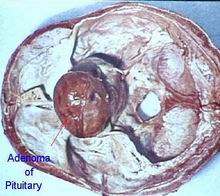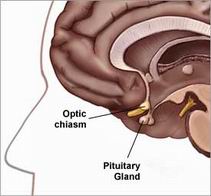About 15% of the tumors originating within the human skull arise in the pituitary gland.
These are medically termed pituitary adenomas.
They are largely classified on the basis of their size. The ones which are larger than 1 cm are called macroadenomas and smaller ones are called microadenomas.
Due to their extremely small size, microadenomas remain undetected and constitute the majority of pituitary adenomas reported, at 16.7%, out of which 14.4% are revealed in post-mortem reports and 22% in radiological reports. (more statistical information here)
For a long time, it was believed that pituitary adenomas rarely assumed clinically active form. However, this perception has been changed by research showing that such effect 1 in 1000 people.

Table of Contents
Overview
The pituitary gland secretes vital hormones into the bloodstream and regulates several critical functions of the human body, such as metabolic processes, mood control, and growth.
This gland, referred to as the “Master Gland” of the body, is located right below the human brain and is divided into two lobes.

Classification
Different pituitary adenomas have structural, histological and functional differences.
They are classified on the basis of the hormone they secrete. The non-functioning tumors which are not capable of secreting any hormones are referred to as “chromophobic” or null cell adenomas.
The various types of pituitary adenomas are:
- Lactotrophic adenomas or Prolactinomas – The most common type of pituitary adenoma detected due to high Prolactin levels in the blood.
- Somatotrophic adenomas – Characterized by stunted or abnormal growth.
- Corticotrophic adenomas – Characterized by Cushing’s disease.
- Gonadotrophic adenomas – Usually causes no symptoms.
- Thyrotrophic adenomas (rare) – Usually no symptoms, but occasionally hyperthyroidism
- Null cell adenomas – There is no hormone secretion.


Pituitary Incidentalomas
All the pituitary adenomas that are incidentally discovered during the diagnosis of some other medical condition, either during a CAT scan or an MRI, are called pituitary incidentalomas.
These may be detected during a diagnostic test suggested for unrelated symptoms like excessive or persistent headache, some forms of cancer or unexplained dizziness.
They could even be detected during an autopsy.

There aren’t enough reliable studies to support the hypothesized benign nature of pituitary microadenomas.
However, their presence has been associated with suicidal tendencies because of their detection in autopsy reports in cases of suicide.
Clinical Practice Guidelines (2011) laid down by the Endocrine Society strongly recommend that if pituitary incidentaloma is detected, an individual must be proactive in going for a complete body examination, and their medical history should be reviewed closely.
If the position of the tumor is near the optical system, a detailed investigation of the visual field must be carried out.
If it is not possible or necessary to remove the Insensitive pituitary adenoma with surgical treatment, regular clinical investigations, visual-field examinations, and neuroimaging are necessary.
Metastases to the Pituitary Gland
It is very rare that a particular type of cancer will metastasize into the pituitary gland. The most common diseases with this characteristic are breast and lung cancers; 6% to 8% of the breast cancers reported are known to metastasize into the pituitary.

Physical Symptoms
- Pituitary Adenomas secrete excessive hormones in the body, creating an imbalance and causing one of the many forms of a condition called hyperpituitarism. The symptoms vary according to the functions and nature of the hormone or hormones secreted.
- A pituitary adenoma may put undue pressure on the optic nerve and cause bitemporal hemianopia. In this condition of partial blindness, the patient loses vision in the outer half of both the visual fields.
- Enhanced strain in the intracranial region could also result due to a pituitary adenoma. This condition could destroy some healthy brain tissues, cause displacement in structures within the brain and curb the amount of blood reaching the brain.
- Frequent headaches may occur for no apparent reason.
Pituitary Adenomas could compress a normally-functioning pituitary gland and can cause a condition called hypopituitarism, resulting in the following symptoms:
- Sexual malfunction and/or decline in sex drive
- Insufficient cortisol levels in the body amounting to low blood pressure, exhaustion, and failure to handle stressful conditions
- Hypothyroidism – Inadequate functioning of the thyroid gland
Psychiatric Symptoms
Pituitary Adenomas may manifest as hostility, depression, apathy, increased irritability, anxiety and emotional insecurity in a patient.
Diagnosis
A pituitary adenoma can be diagnosed or suspected due to the presence of either a few or many of the interrelated symptoms associated with it that are discussed above.
A macroadenoma is usually detected due to the visual problems it causes due to its size and resultant pressure produced.
A confirmed diagnosis is reached by analyzing the level of hormones in the blood and by conducting a CT scan or an MRI of the pituitary gland.
Treatment
Treatment plans are worked out based on the size and nature of the tumor, its invasiveness and the medical history of the patient.
- Prolactinomas are the most commonly occurring pituitary adenomas and are often treated only non-surgically. The patient is administered certain drugs that reduce the size of the tumor and relieve the symptoms. The doctor will regularly monitor the tumor via radiographic imaging techniques for any incremental change in tumor size.
In the case of a large-sized tumor, radiation therapy or surgical treatment is opted for, and these are both known to give good results.
- Somatotrophic adenomas are treated with Octreotide -– a synthetic substitute for natural Somatostatin. Many, but not all, patients respond well to this treatment.
- The surgical procedure is a more common form of treatment for pituitary adenomas. Transsphenoidal surgery is employed to remove the tumor without disturbing other regions within the brain. Recently, endoscopic surgery is commonly employed.
Radiation therapy
- A procedure in which a high radiation dosage is administered to target the tumor in the pituitary gland is called stereotactic radiotherapy. With this technique, only a minuscule amount of radiation reaches the surrounding brain regions.
- Certain advanced radiation therapy techniques like the Novalis Beam-Shaped system have also come into play for the treatment of aberrantly shaped pituitary adenomas in the vicinity of critical parts of the human brain.
Radiation therapy is employed for the treatment of pituitary adenomas.
However, one of the major reasons why it shouldn’t be used is that it gradually causes complete failure of the pituitary gland in the patient. Normally, such a condition arises many years after the patient is subjected to radiation treatment. The only solution to this condition is the total hormone replacement.
For this reason, radiation treatment is usually held in reserve for pituitary adenomas which are not removable via surgery and cannot be inhibited with medical drug administration.




